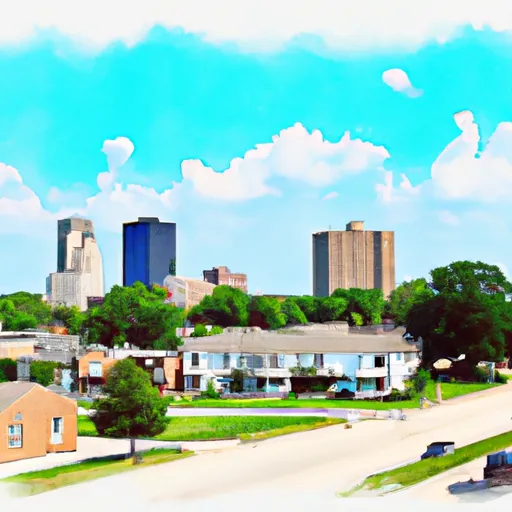-
 Snoflo Premium
Snoflo Premium
Get unlimited access to all our content
With no Ad interruptions! - Start Your Free Trial Login with existing account
Preemption
Eden Index
Climate
7.8
•
Recreation
3.2
•
Community
1.0
•
Safeguard
4.5/10

Preemption, Illinois is a small village located in Mercer County. Situated in the Midwest region, the climate of Preemption is characterized by hot summers and cold winters. Summers bring warm temperatures, averaging around 83°F, while winters can be chilly with average temperatures around 25°F. The area experiences moderate precipitation throughout the year.
In terms of hydrology constituents, Preemption's geography is influenced by the Rock River, which flows through the region. The river provides a source of water and contributes to the local ecosystem. The area also has several smaller bodies of water, including lakes and ponds, which offer opportunities for fishing and other water-based activities.
Preemption is known for its abundant outdoor recreation opportunities. The village is surrounded by picturesque countryside, making it ideal for activities like hiking, camping, and bird watching. The nearby forests and parks offer opportunities for nature enthusiasts to explore and enjoy the natural beauty of the area. Preemption also has open spaces and parks where residents and visitors can engage in various outdoor activities, such as picnicking, playing sports, and hosting community events. Overall, Preemption, Illinois provides a charming setting for outdoor enthusiasts to immerse themselves in nature and enjoy a range of recreational activities.
What is the Eden Index?
The Snoflo Eden Index serves as a comprehensive rating system for regions, evaluating their desirability through a holistic assessment of climate health, outdoor recreation opportunities, and natural disaster risk, acknowledging the profound impact of these factors on livability and well-being.
Climate Health Indicator (CHI): 7.8
Preemption receives approximately
932mm of rain per year,
with humidity levels near 81%
and air temperatures averaging around
10°C.
Preemption has a plant hardyness factor of
5, meaning
plants and agriculture in this region thrive during a short period during spring and early summer. Most
plants will die off during the colder winter months.
By considering the ideal temperature range, reliable water supplies, clean air, and stable seasonal rain or snowpacks, the Climate Health Indicator (CHI) underscores the significance of a healthy climate as the foundation for quality living.
A healthy climate is paramount for ensuring a high quality of life and livability in a region, fostering both physical well-being and environmental harmony. This can be characterized by ideal temperatures, reliable access to water supplies, clean air, and consistent seasonal rain or snowpacks.
Weather Forecast
Streamflow Conditions
Upper Mississippi-Skunk-Wapsipinicon
Area Rivers
Upper Mississippi-Skunk-Wapsipinicon
Snowpack Depths
Upper Mississippi-Skunk-Wapsipinicon
Reservoir Storage Capacity
Upper Mississippi-Skunk-Wapsipinicon
Groundwater Levels
Recreational Opportunity Index (ROI): 3.2
The Recreational Opportunity Index (ROI) recognizes the value of outdoor recreational options, such as parks, hiking trails, camping sites, and fishing spots, while acknowledging that climate plays a pivotal role in ensuring the comfort and consistency of these experiences.
Access to outdoor recreational opportunities, encompassing activities such as parks, hiking, camping, and fishing, is crucial for overall well-being, and the climate plays a pivotal role in enabling and enhancing these experiences, ensuring that individuals can engage in nature-based activities comfortably and consistently.
Camping Areas
| Campground | Campsites | Reservations | Toilets | Showers | Elevation |
|---|---|---|---|---|---|
| North Rec Composite | 15 | 97 ft | |||
| Percy Quin State Park | None | 416 ft | |||
| St. Francois State Park | None | 777 ft | |||
| Babler Memorial State Park | None | 733 ft | |||
| Rocky Springs - Natchez Trace Pkwy | 22 | 235 ft | |||
| South Recreation Composite | 100 | 140 ft | |||
| Tickfaw State Park | None | 15 ft | |||
| Washington State Park | None | 637 ft | |||
| St. Peters 370 Lakeside Park | 50 | 426 ft | |||
| Pere Marquette State Park | 80 | 644 ft |
Nearby Ski Areas
Catastrophe Safeguard Index (CSI):
The Catastrophe Safeguard Index (CSI) recognizes that natural disaster risk, encompassing floods, fires, hurricanes, and tornadoes, can drastically affect safety and the overall appeal of an area.
The level of natural disaster risk in a region significantly affects safety and the overall livability, with climate change amplifying these risks by potentially increasing the frequency and intensity of events like floods, fires, hurricanes, and tornadoes, thereby posing substantial challenges to community resilience and well-being.
Community Resilience Indicator (CRI): 1.0
The Community Resilience Indicator (CRI) recognizes that education, healthcare, and socioeconomics are crucial to the well-being of a region. The CRI acknowledges the profound impact of these elements on residents' overall quality of life. By evaluating educational resources, healthcare accessibility, and economic inclusivity, the index captures the essential aspects that contribute to a thriving community, fostering resident satisfaction, equity, and social cohesion.

